Singapore Green Plan 2012: Urban Sustainability Practices Report
VerifiedAdded on 2023/06/04
|15
|3314
|388
Report
AI Summary
This report provides a detailed analysis of the Singapore Green Plan 2012, examining its objectives, key measures, and effectiveness in promoting urban sustainability. The plan, initiated by the Ministry of the Environment and Water Resources, aimed to address environmental challenges such as high population density and waste management issues. The report explores the plan's emphasis on air quality monitoring, vehicular emission standards, water conservation, and the National Recycling Programme. It highlights the involvement of the public, private, and public sectors, as well as the plan's goals, including waste recycling targets, green space expansion, and biodiversity conservation. The report also discusses the plan's successes, such as reduced particulate matter and increased recycling rates, while acknowledging limitations like the use of natural gas and the need for greater private sector participation. Finally, the report emphasizes the plan's influence on global green initiatives and its expansion to 2030 with more ambitious targets, presenting it as a blueprint for urban sustainability in Singapore.
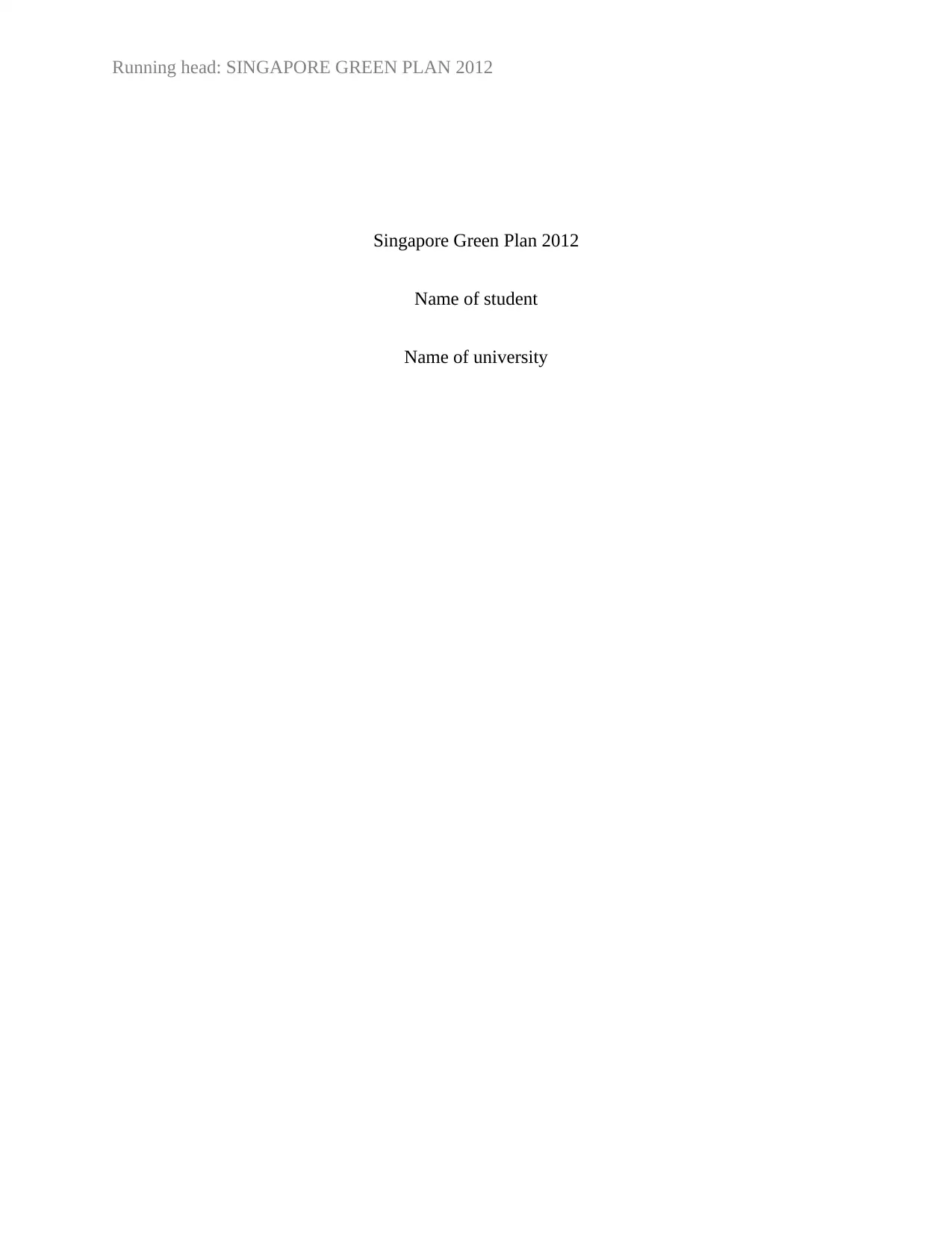
Running head: SINGAPORE GREEN PLAN 2012
Singapore Green Plan 2012
Name of student
Name of university
Singapore Green Plan 2012
Name of student
Name of university
Paraphrase This Document
Need a fresh take? Get an instant paraphrase of this document with our AI Paraphraser
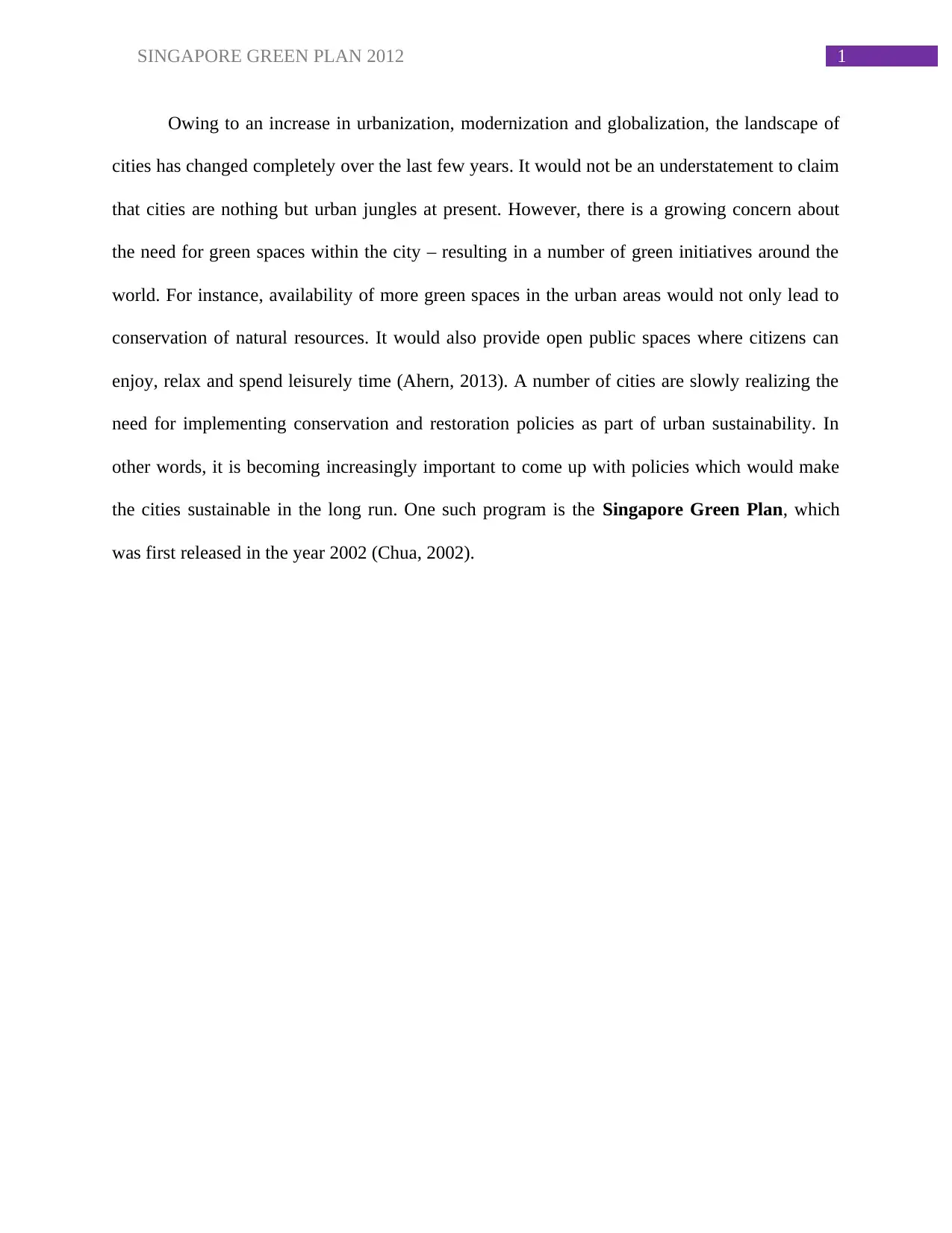
1SINGAPORE GREEN PLAN 2012
Owing to an increase in urbanization, modernization and globalization, the landscape of
cities has changed completely over the last few years. It would not be an understatement to claim
that cities are nothing but urban jungles at present. However, there is a growing concern about
the need for green spaces within the city – resulting in a number of green initiatives around the
world. For instance, availability of more green spaces in the urban areas would not only lead to
conservation of natural resources. It would also provide open public spaces where citizens can
enjoy, relax and spend leisurely time (Ahern, 2013). A number of cities are slowly realizing the
need for implementing conservation and restoration policies as part of urban sustainability. In
other words, it is becoming increasingly important to come up with policies which would make
the cities sustainable in the long run. One such program is the Singapore Green Plan, which
was first released in the year 2002 (Chua, 2002).
Owing to an increase in urbanization, modernization and globalization, the landscape of
cities has changed completely over the last few years. It would not be an understatement to claim
that cities are nothing but urban jungles at present. However, there is a growing concern about
the need for green spaces within the city – resulting in a number of green initiatives around the
world. For instance, availability of more green spaces in the urban areas would not only lead to
conservation of natural resources. It would also provide open public spaces where citizens can
enjoy, relax and spend leisurely time (Ahern, 2013). A number of cities are slowly realizing the
need for implementing conservation and restoration policies as part of urban sustainability. In
other words, it is becoming increasingly important to come up with policies which would make
the cities sustainable in the long run. One such program is the Singapore Green Plan, which
was first released in the year 2002 (Chua, 2002).
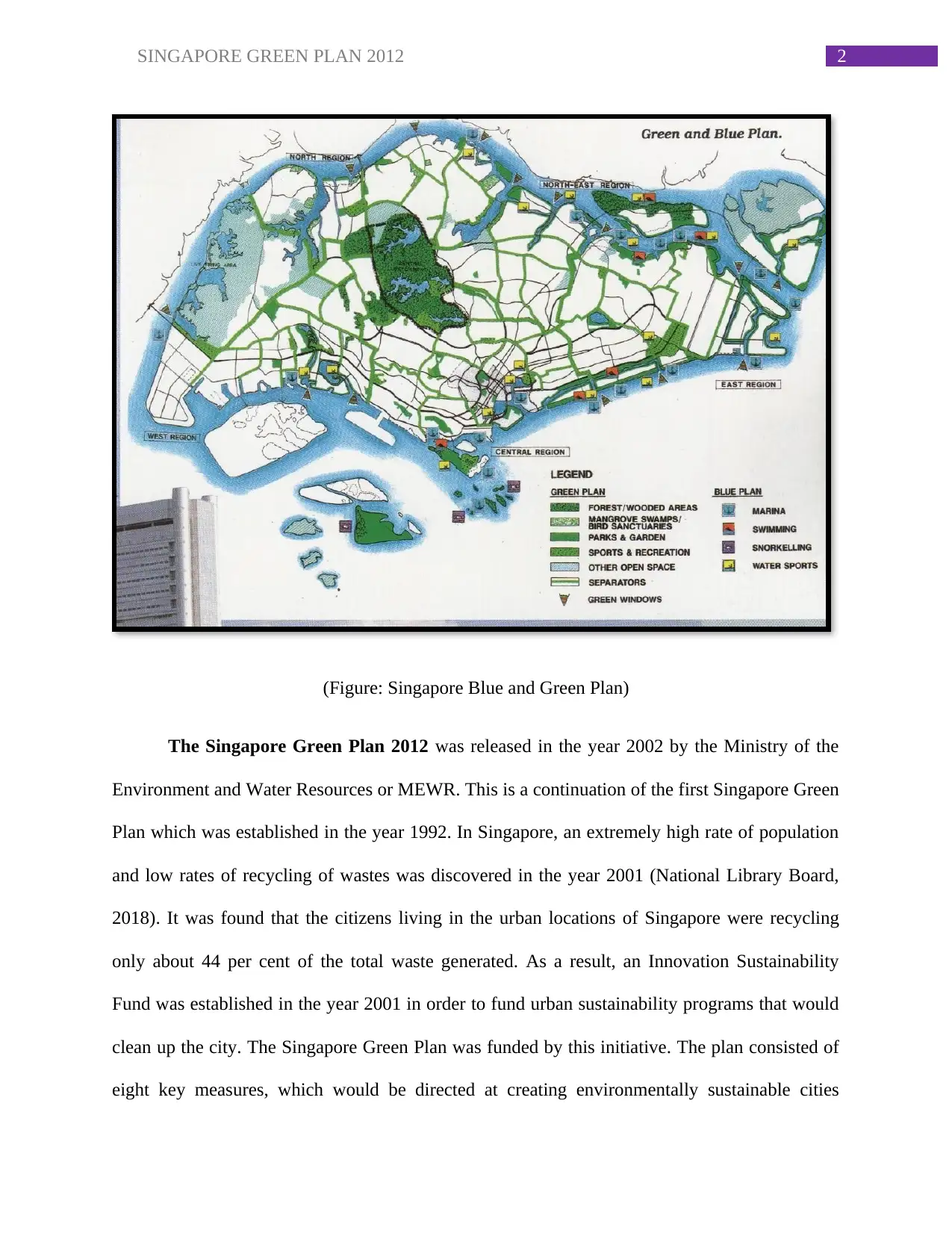
2SINGAPORE GREEN PLAN 2012
(Figure: Singapore Blue and Green Plan)
The Singapore Green Plan 2012 was released in the year 2002 by the Ministry of the
Environment and Water Resources or MEWR. This is a continuation of the first Singapore Green
Plan which was established in the year 1992. In Singapore, an extremely high rate of population
and low rates of recycling of wastes was discovered in the year 2001 (National Library Board,
2018). It was found that the citizens living in the urban locations of Singapore were recycling
only about 44 per cent of the total waste generated. As a result, an Innovation Sustainability
Fund was established in the year 2001 in order to fund urban sustainability programs that would
clean up the city. The Singapore Green Plan was funded by this initiative. The plan consisted of
eight key measures, which would be directed at creating environmentally sustainable cities
(Figure: Singapore Blue and Green Plan)
The Singapore Green Plan 2012 was released in the year 2002 by the Ministry of the
Environment and Water Resources or MEWR. This is a continuation of the first Singapore Green
Plan which was established in the year 1992. In Singapore, an extremely high rate of population
and low rates of recycling of wastes was discovered in the year 2001 (National Library Board,
2018). It was found that the citizens living in the urban locations of Singapore were recycling
only about 44 per cent of the total waste generated. As a result, an Innovation Sustainability
Fund was established in the year 2001 in order to fund urban sustainability programs that would
clean up the city. The Singapore Green Plan was funded by this initiative. The plan consisted of
eight key measures, which would be directed at creating environmentally sustainable cities
⊘ This is a preview!⊘
Do you want full access?
Subscribe today to unlock all pages.

Trusted by 1+ million students worldwide
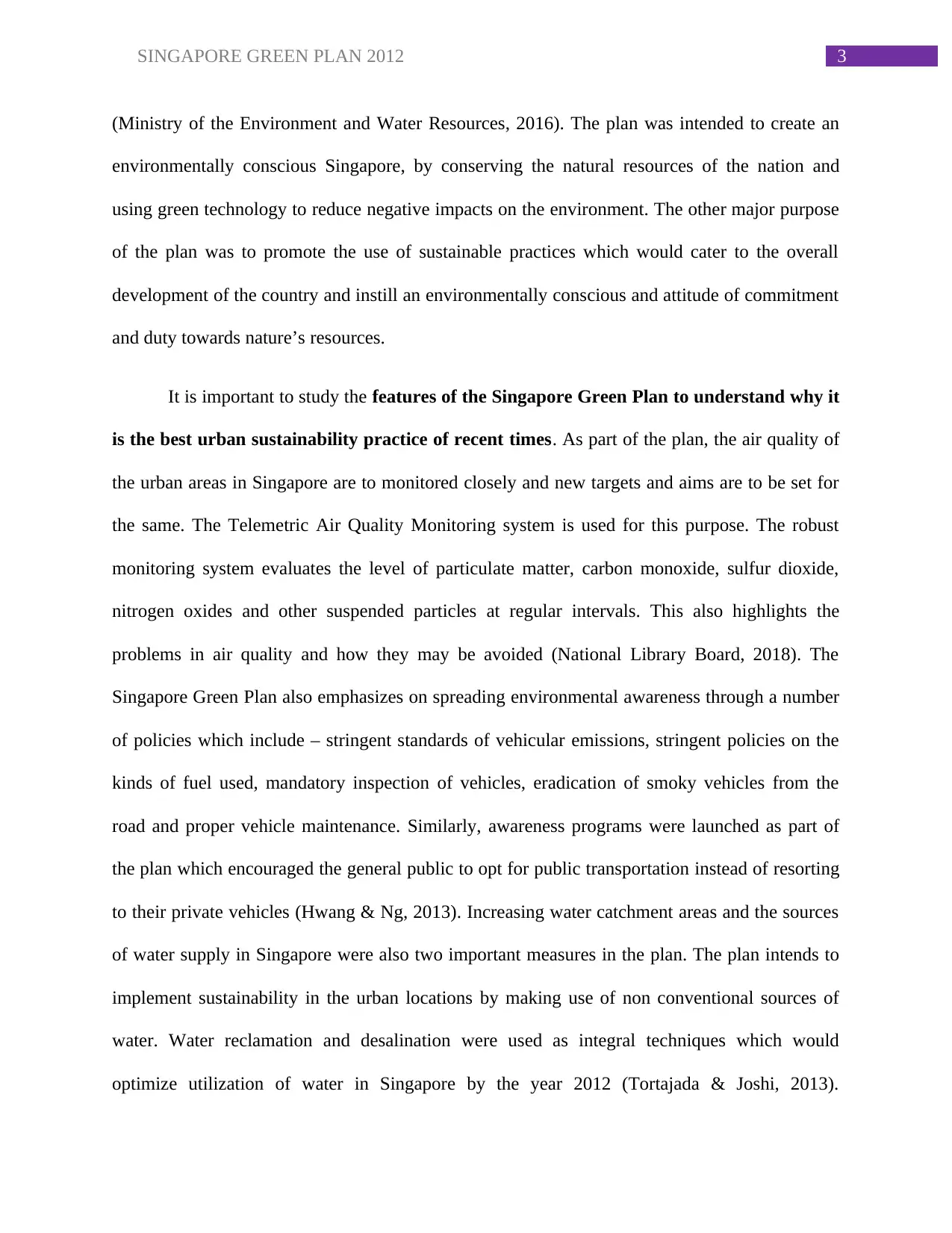
3SINGAPORE GREEN PLAN 2012
(Ministry of the Environment and Water Resources, 2016). The plan was intended to create an
environmentally conscious Singapore, by conserving the natural resources of the nation and
using green technology to reduce negative impacts on the environment. The other major purpose
of the plan was to promote the use of sustainable practices which would cater to the overall
development of the country and instill an environmentally conscious and attitude of commitment
and duty towards nature’s resources.
It is important to study the features of the Singapore Green Plan to understand why it
is the best urban sustainability practice of recent times. As part of the plan, the air quality of
the urban areas in Singapore are to monitored closely and new targets and aims are to be set for
the same. The Telemetric Air Quality Monitoring system is used for this purpose. The robust
monitoring system evaluates the level of particulate matter, carbon monoxide, sulfur dioxide,
nitrogen oxides and other suspended particles at regular intervals. This also highlights the
problems in air quality and how they may be avoided (National Library Board, 2018). The
Singapore Green Plan also emphasizes on spreading environmental awareness through a number
of policies which include – stringent standards of vehicular emissions, stringent policies on the
kinds of fuel used, mandatory inspection of vehicles, eradication of smoky vehicles from the
road and proper vehicle maintenance. Similarly, awareness programs were launched as part of
the plan which encouraged the general public to opt for public transportation instead of resorting
to their private vehicles (Hwang & Ng, 2013). Increasing water catchment areas and the sources
of water supply in Singapore were also two important measures in the plan. The plan intends to
implement sustainability in the urban locations by making use of non conventional sources of
water. Water reclamation and desalination were used as integral techniques which would
optimize utilization of water in Singapore by the year 2012 (Tortajada & Joshi, 2013).
(Ministry of the Environment and Water Resources, 2016). The plan was intended to create an
environmentally conscious Singapore, by conserving the natural resources of the nation and
using green technology to reduce negative impacts on the environment. The other major purpose
of the plan was to promote the use of sustainable practices which would cater to the overall
development of the country and instill an environmentally conscious and attitude of commitment
and duty towards nature’s resources.
It is important to study the features of the Singapore Green Plan to understand why it
is the best urban sustainability practice of recent times. As part of the plan, the air quality of
the urban areas in Singapore are to monitored closely and new targets and aims are to be set for
the same. The Telemetric Air Quality Monitoring system is used for this purpose. The robust
monitoring system evaluates the level of particulate matter, carbon monoxide, sulfur dioxide,
nitrogen oxides and other suspended particles at regular intervals. This also highlights the
problems in air quality and how they may be avoided (National Library Board, 2018). The
Singapore Green Plan also emphasizes on spreading environmental awareness through a number
of policies which include – stringent standards of vehicular emissions, stringent policies on the
kinds of fuel used, mandatory inspection of vehicles, eradication of smoky vehicles from the
road and proper vehicle maintenance. Similarly, awareness programs were launched as part of
the plan which encouraged the general public to opt for public transportation instead of resorting
to their private vehicles (Hwang & Ng, 2013). Increasing water catchment areas and the sources
of water supply in Singapore were also two important measures in the plan. The plan intends to
implement sustainability in the urban locations by making use of non conventional sources of
water. Water reclamation and desalination were used as integral techniques which would
optimize utilization of water in Singapore by the year 2012 (Tortajada & Joshi, 2013).
Paraphrase This Document
Need a fresh take? Get an instant paraphrase of this document with our AI Paraphraser
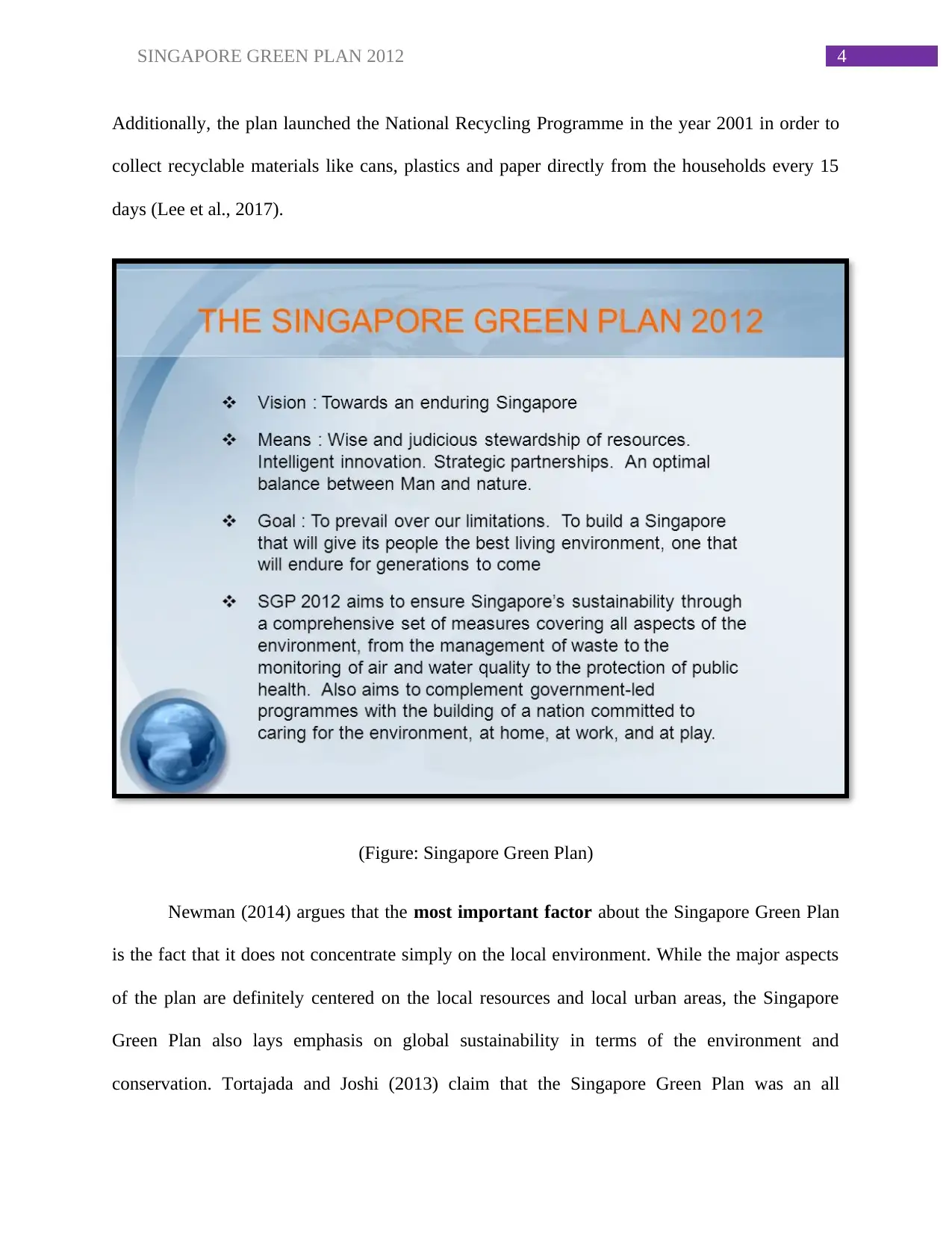
4SINGAPORE GREEN PLAN 2012
Additionally, the plan launched the National Recycling Programme in the year 2001 in order to
collect recyclable materials like cans, plastics and paper directly from the households every 15
days (Lee et al., 2017).
(Figure: Singapore Green Plan)
Newman (2014) argues that the most important factor about the Singapore Green Plan
is the fact that it does not concentrate simply on the local environment. While the major aspects
of the plan are definitely centered on the local resources and local urban areas, the Singapore
Green Plan also lays emphasis on global sustainability in terms of the environment and
conservation. Tortajada and Joshi (2013) claim that the Singapore Green Plan was an all
Additionally, the plan launched the National Recycling Programme in the year 2001 in order to
collect recyclable materials like cans, plastics and paper directly from the households every 15
days (Lee et al., 2017).
(Figure: Singapore Green Plan)
Newman (2014) argues that the most important factor about the Singapore Green Plan
is the fact that it does not concentrate simply on the local environment. While the major aspects
of the plan are definitely centered on the local resources and local urban areas, the Singapore
Green Plan also lays emphasis on global sustainability in terms of the environment and
conservation. Tortajada and Joshi (2013) claim that the Singapore Green Plan was an all
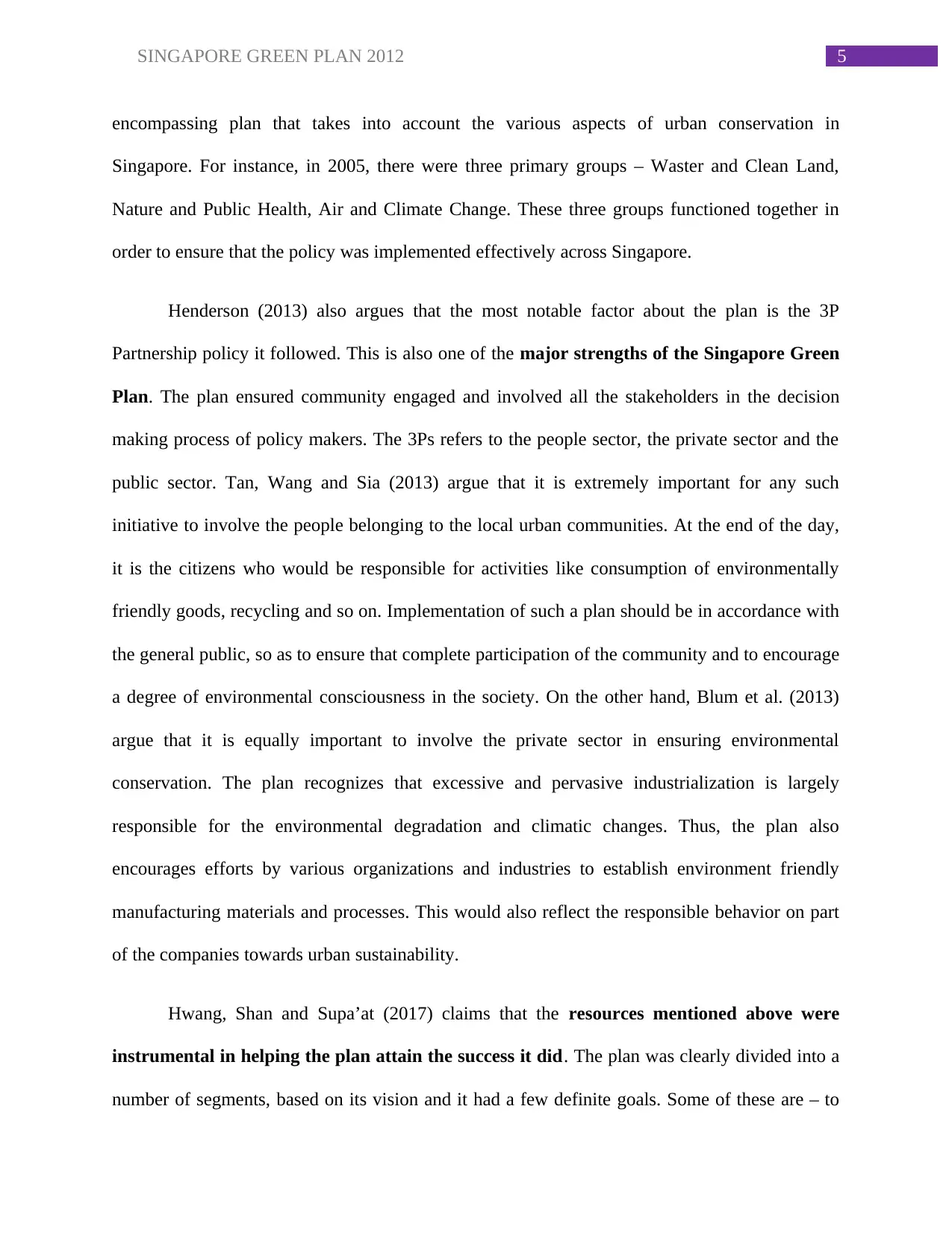
5SINGAPORE GREEN PLAN 2012
encompassing plan that takes into account the various aspects of urban conservation in
Singapore. For instance, in 2005, there were three primary groups – Waster and Clean Land,
Nature and Public Health, Air and Climate Change. These three groups functioned together in
order to ensure that the policy was implemented effectively across Singapore.
Henderson (2013) also argues that the most notable factor about the plan is the 3P
Partnership policy it followed. This is also one of the major strengths of the Singapore Green
Plan. The plan ensured community engaged and involved all the stakeholders in the decision
making process of policy makers. The 3Ps refers to the people sector, the private sector and the
public sector. Tan, Wang and Sia (2013) argue that it is extremely important for any such
initiative to involve the people belonging to the local urban communities. At the end of the day,
it is the citizens who would be responsible for activities like consumption of environmentally
friendly goods, recycling and so on. Implementation of such a plan should be in accordance with
the general public, so as to ensure that complete participation of the community and to encourage
a degree of environmental consciousness in the society. On the other hand, Blum et al. (2013)
argue that it is equally important to involve the private sector in ensuring environmental
conservation. The plan recognizes that excessive and pervasive industrialization is largely
responsible for the environmental degradation and climatic changes. Thus, the plan also
encourages efforts by various organizations and industries to establish environment friendly
manufacturing materials and processes. This would also reflect the responsible behavior on part
of the companies towards urban sustainability.
Hwang, Shan and Supa’at (2017) claims that the resources mentioned above were
instrumental in helping the plan attain the success it did. The plan was clearly divided into a
number of segments, based on its vision and it had a few definite goals. Some of these are – to
encompassing plan that takes into account the various aspects of urban conservation in
Singapore. For instance, in 2005, there were three primary groups – Waster and Clean Land,
Nature and Public Health, Air and Climate Change. These three groups functioned together in
order to ensure that the policy was implemented effectively across Singapore.
Henderson (2013) also argues that the most notable factor about the plan is the 3P
Partnership policy it followed. This is also one of the major strengths of the Singapore Green
Plan. The plan ensured community engaged and involved all the stakeholders in the decision
making process of policy makers. The 3Ps refers to the people sector, the private sector and the
public sector. Tan, Wang and Sia (2013) argue that it is extremely important for any such
initiative to involve the people belonging to the local urban communities. At the end of the day,
it is the citizens who would be responsible for activities like consumption of environmentally
friendly goods, recycling and so on. Implementation of such a plan should be in accordance with
the general public, so as to ensure that complete participation of the community and to encourage
a degree of environmental consciousness in the society. On the other hand, Blum et al. (2013)
argue that it is equally important to involve the private sector in ensuring environmental
conservation. The plan recognizes that excessive and pervasive industrialization is largely
responsible for the environmental degradation and climatic changes. Thus, the plan also
encourages efforts by various organizations and industries to establish environment friendly
manufacturing materials and processes. This would also reflect the responsible behavior on part
of the companies towards urban sustainability.
Hwang, Shan and Supa’at (2017) claims that the resources mentioned above were
instrumental in helping the plan attain the success it did. The plan was clearly divided into a
number of segments, based on its vision and it had a few definite goals. Some of these are – to
⊘ This is a preview!⊘
Do you want full access?
Subscribe today to unlock all pages.

Trusted by 1+ million students worldwide
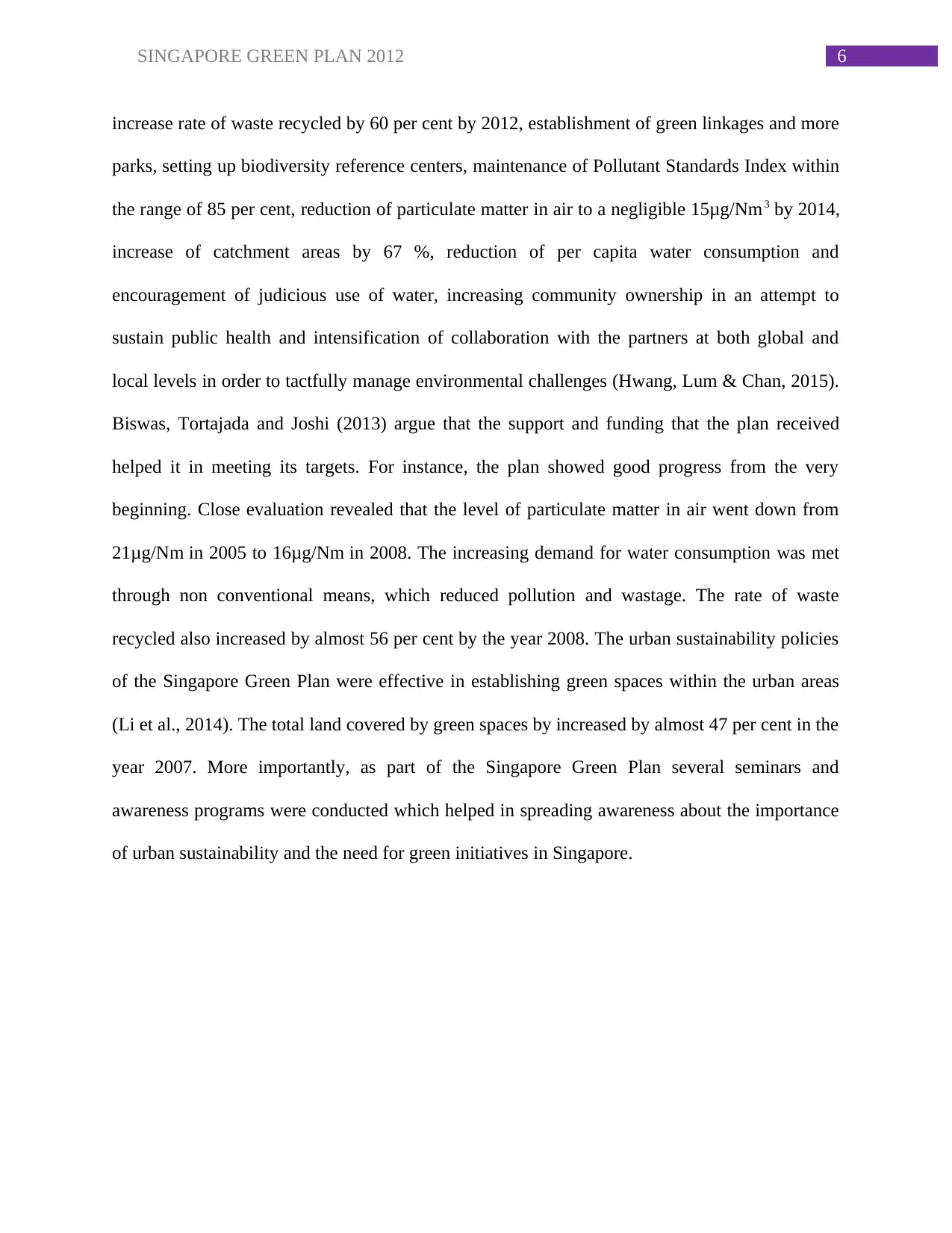
6SINGAPORE GREEN PLAN 2012
increase rate of waste recycled by 60 per cent by 2012, establishment of green linkages and more
parks, setting up biodiversity reference centers, maintenance of Pollutant Standards Index within
the range of 85 per cent, reduction of particulate matter in air to a negligible 15μg/Nm3 by 2014,
increase of catchment areas by 67 %, reduction of per capita water consumption and
encouragement of judicious use of water, increasing community ownership in an attempt to
sustain public health and intensification of collaboration with the partners at both global and
local levels in order to tactfully manage environmental challenges (Hwang, Lum & Chan, 2015).
Biswas, Tortajada and Joshi (2013) argue that the support and funding that the plan received
helped it in meeting its targets. For instance, the plan showed good progress from the very
beginning. Close evaluation revealed that the level of particulate matter in air went down from
21μg/Nm in 2005 to 16μg/Nm in 2008. The increasing demand for water consumption was met
through non conventional means, which reduced pollution and wastage. The rate of waste
recycled also increased by almost 56 per cent by the year 2008. The urban sustainability policies
of the Singapore Green Plan were effective in establishing green spaces within the urban areas
(Li et al., 2014). The total land covered by green spaces by increased by almost 47 per cent in the
year 2007. More importantly, as part of the Singapore Green Plan several seminars and
awareness programs were conducted which helped in spreading awareness about the importance
of urban sustainability and the need for green initiatives in Singapore.
increase rate of waste recycled by 60 per cent by 2012, establishment of green linkages and more
parks, setting up biodiversity reference centers, maintenance of Pollutant Standards Index within
the range of 85 per cent, reduction of particulate matter in air to a negligible 15μg/Nm3 by 2014,
increase of catchment areas by 67 %, reduction of per capita water consumption and
encouragement of judicious use of water, increasing community ownership in an attempt to
sustain public health and intensification of collaboration with the partners at both global and
local levels in order to tactfully manage environmental challenges (Hwang, Lum & Chan, 2015).
Biswas, Tortajada and Joshi (2013) argue that the support and funding that the plan received
helped it in meeting its targets. For instance, the plan showed good progress from the very
beginning. Close evaluation revealed that the level of particulate matter in air went down from
21μg/Nm in 2005 to 16μg/Nm in 2008. The increasing demand for water consumption was met
through non conventional means, which reduced pollution and wastage. The rate of waste
recycled also increased by almost 56 per cent by the year 2008. The urban sustainability policies
of the Singapore Green Plan were effective in establishing green spaces within the urban areas
(Li et al., 2014). The total land covered by green spaces by increased by almost 47 per cent in the
year 2007. More importantly, as part of the Singapore Green Plan several seminars and
awareness programs were conducted which helped in spreading awareness about the importance
of urban sustainability and the need for green initiatives in Singapore.
Paraphrase This Document
Need a fresh take? Get an instant paraphrase of this document with our AI Paraphraser
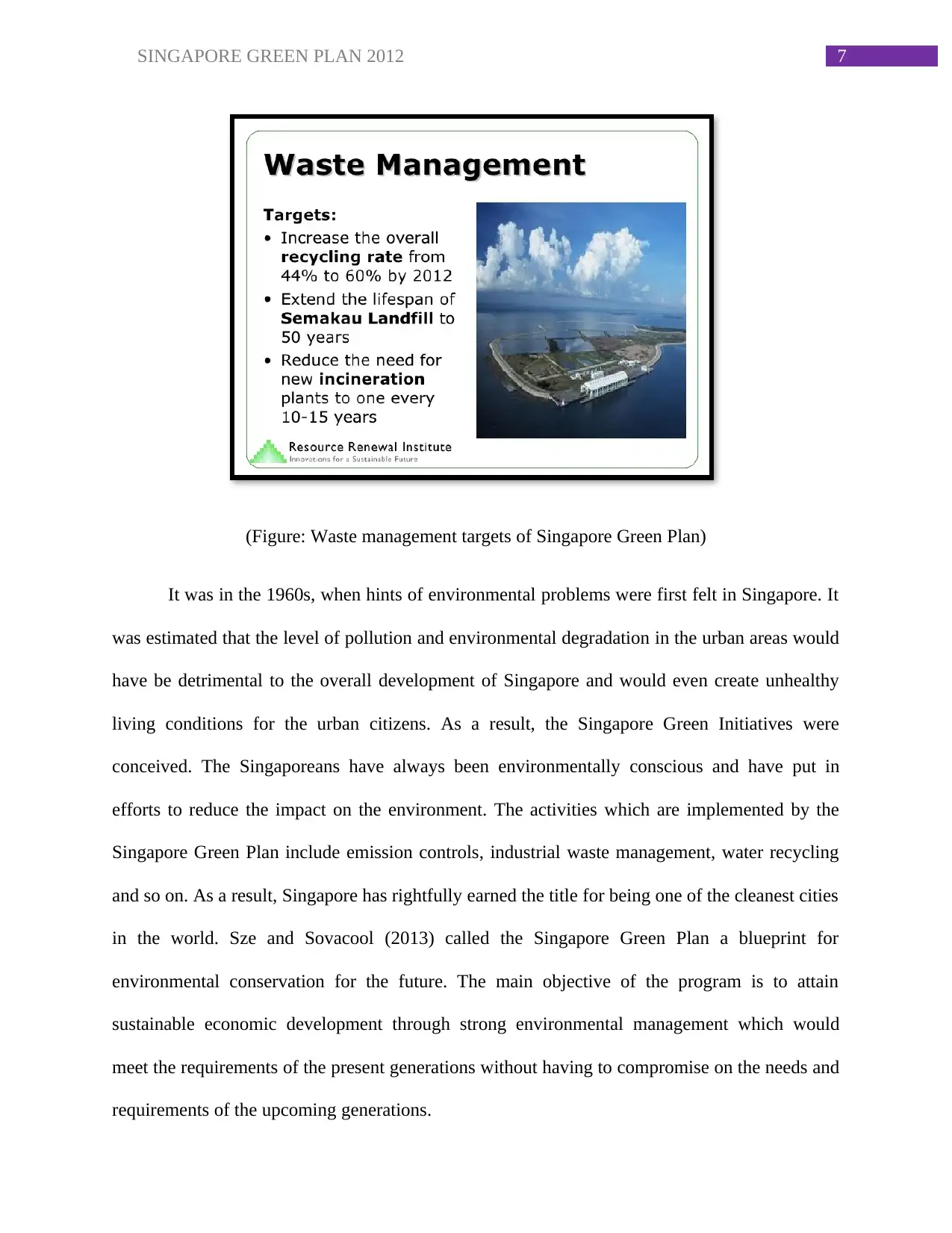
7SINGAPORE GREEN PLAN 2012
(Figure: Waste management targets of Singapore Green Plan)
It was in the 1960s, when hints of environmental problems were first felt in Singapore. It
was estimated that the level of pollution and environmental degradation in the urban areas would
have be detrimental to the overall development of Singapore and would even create unhealthy
living conditions for the urban citizens. As a result, the Singapore Green Initiatives were
conceived. The Singaporeans have always been environmentally conscious and have put in
efforts to reduce the impact on the environment. The activities which are implemented by the
Singapore Green Plan include emission controls, industrial waste management, water recycling
and so on. As a result, Singapore has rightfully earned the title for being one of the cleanest cities
in the world. Sze and Sovacool (2013) called the Singapore Green Plan a blueprint for
environmental conservation for the future. The main objective of the program is to attain
sustainable economic development through strong environmental management which would
meet the requirements of the present generations without having to compromise on the needs and
requirements of the upcoming generations.
(Figure: Waste management targets of Singapore Green Plan)
It was in the 1960s, when hints of environmental problems were first felt in Singapore. It
was estimated that the level of pollution and environmental degradation in the urban areas would
have be detrimental to the overall development of Singapore and would even create unhealthy
living conditions for the urban citizens. As a result, the Singapore Green Initiatives were
conceived. The Singaporeans have always been environmentally conscious and have put in
efforts to reduce the impact on the environment. The activities which are implemented by the
Singapore Green Plan include emission controls, industrial waste management, water recycling
and so on. As a result, Singapore has rightfully earned the title for being one of the cleanest cities
in the world. Sze and Sovacool (2013) called the Singapore Green Plan a blueprint for
environmental conservation for the future. The main objective of the program is to attain
sustainable economic development through strong environmental management which would
meet the requirements of the present generations without having to compromise on the needs and
requirements of the upcoming generations.
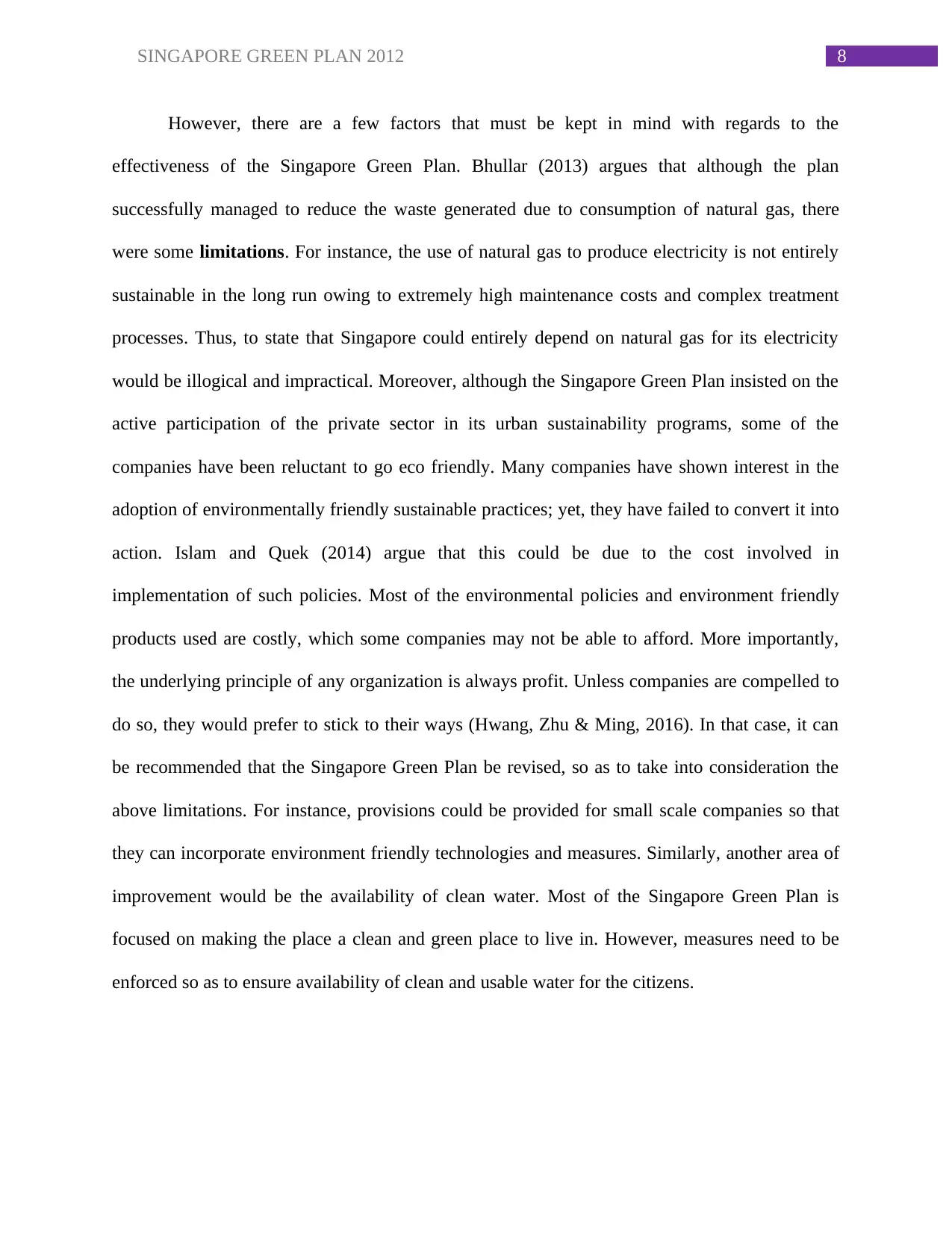
8SINGAPORE GREEN PLAN 2012
However, there are a few factors that must be kept in mind with regards to the
effectiveness of the Singapore Green Plan. Bhullar (2013) argues that although the plan
successfully managed to reduce the waste generated due to consumption of natural gas, there
were some limitations. For instance, the use of natural gas to produce electricity is not entirely
sustainable in the long run owing to extremely high maintenance costs and complex treatment
processes. Thus, to state that Singapore could entirely depend on natural gas for its electricity
would be illogical and impractical. Moreover, although the Singapore Green Plan insisted on the
active participation of the private sector in its urban sustainability programs, some of the
companies have been reluctant to go eco friendly. Many companies have shown interest in the
adoption of environmentally friendly sustainable practices; yet, they have failed to convert it into
action. Islam and Quek (2014) argue that this could be due to the cost involved in
implementation of such policies. Most of the environmental policies and environment friendly
products used are costly, which some companies may not be able to afford. More importantly,
the underlying principle of any organization is always profit. Unless companies are compelled to
do so, they would prefer to stick to their ways (Hwang, Zhu & Ming, 2016). In that case, it can
be recommended that the Singapore Green Plan be revised, so as to take into consideration the
above limitations. For instance, provisions could be provided for small scale companies so that
they can incorporate environment friendly technologies and measures. Similarly, another area of
improvement would be the availability of clean water. Most of the Singapore Green Plan is
focused on making the place a clean and green place to live in. However, measures need to be
enforced so as to ensure availability of clean and usable water for the citizens.
However, there are a few factors that must be kept in mind with regards to the
effectiveness of the Singapore Green Plan. Bhullar (2013) argues that although the plan
successfully managed to reduce the waste generated due to consumption of natural gas, there
were some limitations. For instance, the use of natural gas to produce electricity is not entirely
sustainable in the long run owing to extremely high maintenance costs and complex treatment
processes. Thus, to state that Singapore could entirely depend on natural gas for its electricity
would be illogical and impractical. Moreover, although the Singapore Green Plan insisted on the
active participation of the private sector in its urban sustainability programs, some of the
companies have been reluctant to go eco friendly. Many companies have shown interest in the
adoption of environmentally friendly sustainable practices; yet, they have failed to convert it into
action. Islam and Quek (2014) argue that this could be due to the cost involved in
implementation of such policies. Most of the environmental policies and environment friendly
products used are costly, which some companies may not be able to afford. More importantly,
the underlying principle of any organization is always profit. Unless companies are compelled to
do so, they would prefer to stick to their ways (Hwang, Zhu & Ming, 2016). In that case, it can
be recommended that the Singapore Green Plan be revised, so as to take into consideration the
above limitations. For instance, provisions could be provided for small scale companies so that
they can incorporate environment friendly technologies and measures. Similarly, another area of
improvement would be the availability of clean water. Most of the Singapore Green Plan is
focused on making the place a clean and green place to live in. However, measures need to be
enforced so as to ensure availability of clean and usable water for the citizens.
⊘ This is a preview!⊘
Do you want full access?
Subscribe today to unlock all pages.

Trusted by 1+ million students worldwide
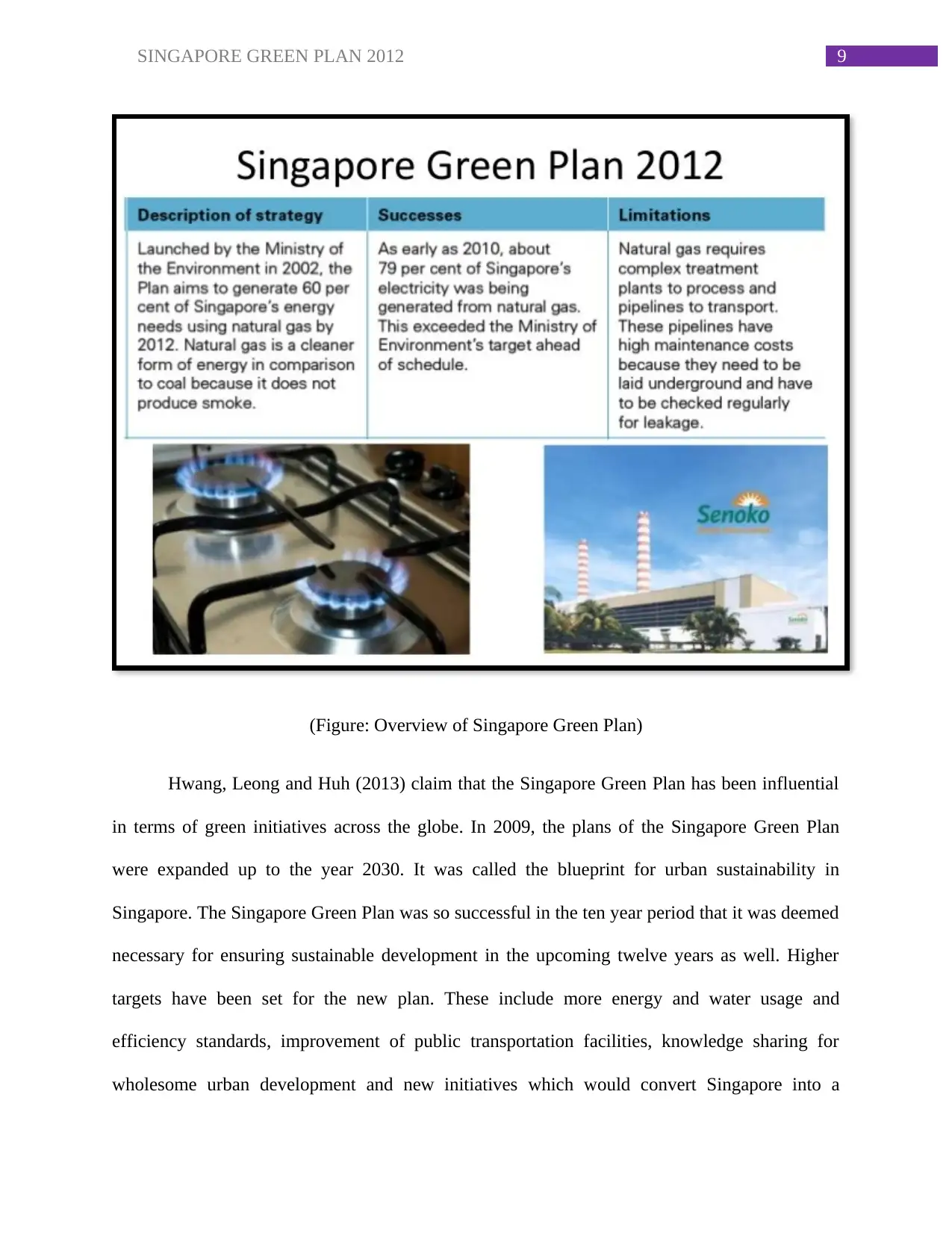
9SINGAPORE GREEN PLAN 2012
(Figure: Overview of Singapore Green Plan)
Hwang, Leong and Huh (2013) claim that the Singapore Green Plan has been influential
in terms of green initiatives across the globe. In 2009, the plans of the Singapore Green Plan
were expanded up to the year 2030. It was called the blueprint for urban sustainability in
Singapore. The Singapore Green Plan was so successful in the ten year period that it was deemed
necessary for ensuring sustainable development in the upcoming twelve years as well. Higher
targets have been set for the new plan. These include more energy and water usage and
efficiency standards, improvement of public transportation facilities, knowledge sharing for
wholesome urban development and new initiatives which would convert Singapore into a
(Figure: Overview of Singapore Green Plan)
Hwang, Leong and Huh (2013) claim that the Singapore Green Plan has been influential
in terms of green initiatives across the globe. In 2009, the plans of the Singapore Green Plan
were expanded up to the year 2030. It was called the blueprint for urban sustainability in
Singapore. The Singapore Green Plan was so successful in the ten year period that it was deemed
necessary for ensuring sustainable development in the upcoming twelve years as well. Higher
targets have been set for the new plan. These include more energy and water usage and
efficiency standards, improvement of public transportation facilities, knowledge sharing for
wholesome urban development and new initiatives which would convert Singapore into a
Paraphrase This Document
Need a fresh take? Get an instant paraphrase of this document with our AI Paraphraser
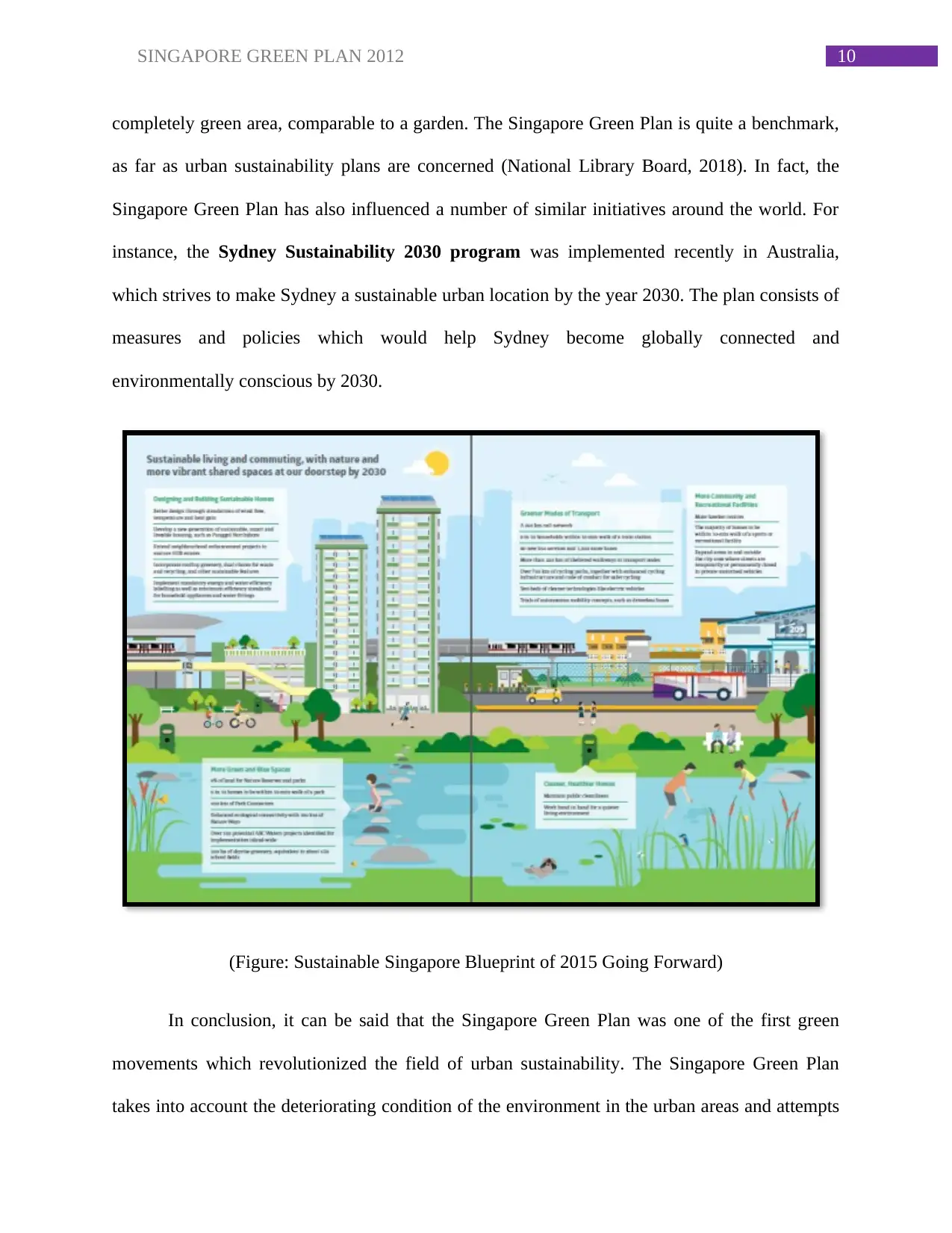
10SINGAPORE GREEN PLAN 2012
completely green area, comparable to a garden. The Singapore Green Plan is quite a benchmark,
as far as urban sustainability plans are concerned (National Library Board, 2018). In fact, the
Singapore Green Plan has also influenced a number of similar initiatives around the world. For
instance, the Sydney Sustainability 2030 program was implemented recently in Australia,
which strives to make Sydney a sustainable urban location by the year 2030. The plan consists of
measures and policies which would help Sydney become globally connected and
environmentally conscious by 2030.
(Figure: Sustainable Singapore Blueprint of 2015 Going Forward)
In conclusion, it can be said that the Singapore Green Plan was one of the first green
movements which revolutionized the field of urban sustainability. The Singapore Green Plan
takes into account the deteriorating condition of the environment in the urban areas and attempts
completely green area, comparable to a garden. The Singapore Green Plan is quite a benchmark,
as far as urban sustainability plans are concerned (National Library Board, 2018). In fact, the
Singapore Green Plan has also influenced a number of similar initiatives around the world. For
instance, the Sydney Sustainability 2030 program was implemented recently in Australia,
which strives to make Sydney a sustainable urban location by the year 2030. The plan consists of
measures and policies which would help Sydney become globally connected and
environmentally conscious by 2030.
(Figure: Sustainable Singapore Blueprint of 2015 Going Forward)
In conclusion, it can be said that the Singapore Green Plan was one of the first green
movements which revolutionized the field of urban sustainability. The Singapore Green Plan
takes into account the deteriorating condition of the environment in the urban areas and attempts
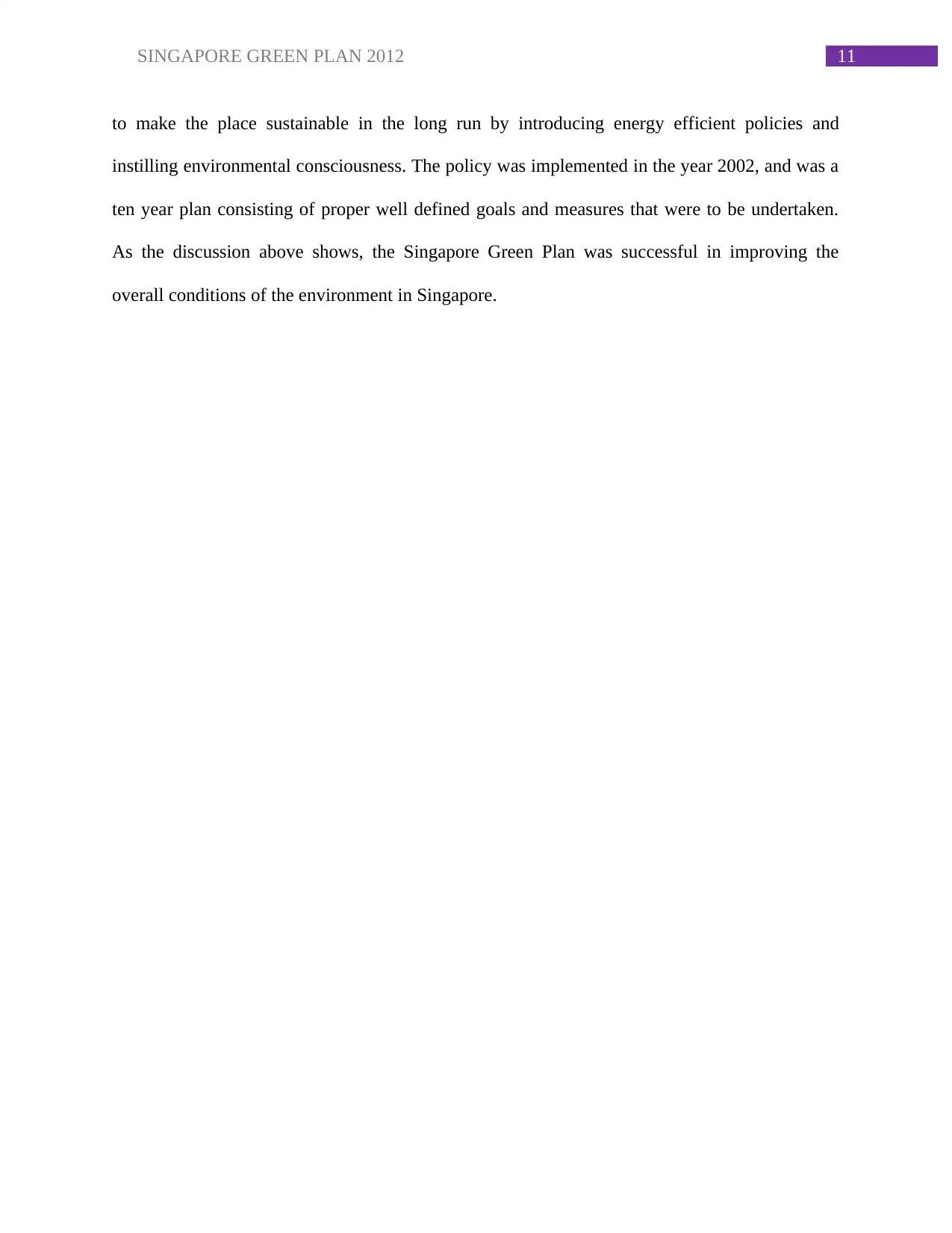
11SINGAPORE GREEN PLAN 2012
to make the place sustainable in the long run by introducing energy efficient policies and
instilling environmental consciousness. The policy was implemented in the year 2002, and was a
ten year plan consisting of proper well defined goals and measures that were to be undertaken.
As the discussion above shows, the Singapore Green Plan was successful in improving the
overall conditions of the environment in Singapore.
to make the place sustainable in the long run by introducing energy efficient policies and
instilling environmental consciousness. The policy was implemented in the year 2002, and was a
ten year plan consisting of proper well defined goals and measures that were to be undertaken.
As the discussion above shows, the Singapore Green Plan was successful in improving the
overall conditions of the environment in Singapore.
⊘ This is a preview!⊘
Do you want full access?
Subscribe today to unlock all pages.

Trusted by 1+ million students worldwide
1 out of 15
Related Documents
Your All-in-One AI-Powered Toolkit for Academic Success.
+13062052269
info@desklib.com
Available 24*7 on WhatsApp / Email
![[object Object]](/_next/static/media/star-bottom.7253800d.svg)
Unlock your academic potential
Copyright © 2020–2025 A2Z Services. All Rights Reserved. Developed and managed by ZUCOL.





